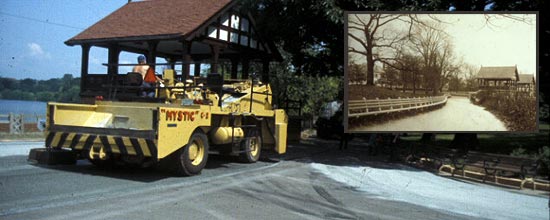

Guidelines for Preserving Cultural Landscapes
Circulation

Identify, Retain, and Preserve Historic Features and Materials
![]()
Identifying, retaining, and preserving the existing circulation systems prior to project work. All circulation features should be documented, from small paths and walks to larger transportation corridors such as parkways, highways, railroads and canals, as well as alignment, surface and edge treatment, width, grade, materials and infrastructure.
Evaluating the existing condition and determining the age of circulation systems. For example, utilizing aerial photographs and historic maps to date the introduction of carriage roads in an expanding rural cemetery.
![]()
Executing project work that impacts circulation systems without undertaking an “existing conditions” survey.
Undertaking work without understanding the importance of circulation systems. For example, closing off historic roads and removing others, thus altering the historic circulation patterns in a fishing village.
Maintain Historic Features and Materials
![]()
Maintaining circulation systems through non-destructive methods in daily, seasonal and cyclical tasks. This may include hand raking, top dressing, or rolling surface materials.
Utilizing maintenance practices that respect infrastructure. For example, cleaning out debris from drainage systems.
![]()
Failing to undertake preventive maintenance of circulation features and materials. For example, using a snow plow across a coarse textured pavement.
Using materials such as salts and chemicals that can hasten the deterioration of surface treatments.
Allowing infrastructure to become dysfunctional. For example, permitting a failed drainage system to contribute to the degradation and loss of associated road surface.
Repair Historic Materials and Features
![]()
Repairing surface treatment, materials and edges. For example, by applying a traditional material to a stabilized subsurface base or patching a railroad corridor retaining wall.
![]()
Replacing or destroying circulation features and materials when repair is possible. For example, removing damaged curbing that could be repaired during a road repaving project.
Limited Replacement In Kind
of Extensively Deteriorated Portions
of Historic Features
![]()
Replacing in-kind circulation features or materials when they are too deteriorated or damaged to be repaired. For example, replacing a worn cinder path with a new material that matches the old in composition, design, color and texture.
![]()
Removing circulation features that are beyond repair when the historic feature or material is available. For example, installing new drainage inlets when the historic prototype survives.
As part of a preservation project, the walks around Boston’s Jamaica Pond Park were repaired and resurfaced. A loose, crushed stone surface material (an embedded aggregate) was rolled into the asphalt surface, thus allowing for upgraded uses such as jogging, biking and snow removal, while retaining the historic character. (FLONHS and author, 1990)